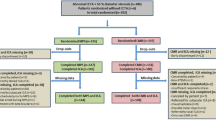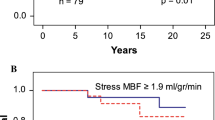Abstract
The prognostic implications of myocardial computed tomography perfusion (CTP) analyses are unknown. In this sub-study to the CATCH-trial we evaluate the ability of adenosine stress CTP findings to predict mid-term major adverse cardiac events (MACE). In 240 patients with acute-onset chest pain, yet normal electrocardiograms and troponins, a clinically blinded adenosine stress CTP scan was performed in addition to conventional diagnostic evaluation. A reversible perfusion defect (PD) was found in 38 patients (16 %) and during a median follow-up of 19 months (range 12–22 months) 25 patients (10 %) suffered a MACE (cardiac death, non-fatal myocardial infarction and revascularizations). Accuracy for the prediction of MACE expressed as the area under curve (AUC) on receiver-operating characteristic curves was 0.88 (0.83–0.92) for visual assessment of a PD and 0.80 (0.73–0.85) for stress TPR (transmural perfusion ratio). After adjustment for the pretest probability of obstructive coronary artery disease, both detection of a PD and stress TPR were significantly associated with MACE with an adjusted hazard ratio of 39 (95 % confidence interval 11–134), p < 0.0001, for visual interpretation and 0.99 (0.98–0.99) for stress TPR, p < 0.0001. Patients with a PD volume covering >10 % of the LV myocardium had a worse prognosis compared to patients with a PD covering <10 % of the LV myocardium, p = 0.0002. The optimal cut-off value of the myocardial PD extent to predict MACE was 5.3 % of the left ventricle [sensitivity 84 % (64–96), specificity 95 % (91–97)]. Myocardial CT perfusion parameters predict mid-term clinical outcome in patients with recent acute-onset chest pain.





Similar content being viewed by others
References
Dorbala S, Di Carli MF, Beanlands RS, Merhige ME, Williams BA, Veledar E, Chow BJ, Min JK, Pencina MJ, Berman DS, Shaw LJ (2013) Prognostic value of stress myocardial perfusion positron emission tomography: results from a multicenter observational registry. J Am Coll Cardiol 61(2):176–184. doi:10.1016/j.jacc.2012.09.043
Gargiulo P, Dellegrottaglie S, Bruzzese D, Savarese G, Scala O, Ruggiero D, D’Amore C, Paolillo S, Agostoni P, Bossone E, Soricelli A, Cuocolo A, Trimarco B, Perrone Filardi P (2013) The prognostic value of normal stress cardiac magnetic resonance in patients with known or suspected coronary artery disease: a meta-analysis. Circ Cardiovasc Imaging 6(4):574–582. doi:10.1161/CIRCIMAGING.113.000035
Pilz G, Jeske A, Klos M, Ali E, Hoefling B, Scheck R, Bernhardt P (2008) Prognostic value of normal adenosine-stress cardiac magnetic resonance imaging. Am J Cardiol 101(10):1408–1412. doi:10.1016/j.amjcard.2008.01.019
Shaw LJ, Hendel R, Borges-Neto S, Lauer MS, Alazraki N, Burnette J, Krawczynska E, Cerqueira M, Maddahi J (2003) Prognostic value of normal exercise and adenosine (99 m) Tc-tetrofosmin SPECT imaging: results from the multicenter registry of 4728 patients. J Nucl Med 44(2):134–139
Hendel RC, Berman DS, Di Carli MF, Heidenreich PA, Henkin RE, Pellikka PA, Pohost GM, Williams KA, American College of Cardiology Foundation Appropriate Use Criteria Task F, American Society of Nuclear C, American College of R, American Heart A, American Society of E, Society of Cardiovascular Computed T, Society for Cardiovascular Magnetic R, Society of Nuclear M (ACCF/ASNC/ACR/AHA/ASE/SCCT/SCMR/SNM) (2009) Appropriate use criteria for cardiac radionuclide imaging: a report of the American College of Cardiology Foundation Appropriate Use Criteria Task Force, the American Society of Nuclear Cardiology, the American College of Radiology, the American Heart Association, the American Society of Echocardiography, the Society of Cardiovascular Computed Tomography, the Society for Cardiovascular Magnetic Resonance, and the Society of Nuclear Medicine. Circulation 119(22):e561–587. doi:10.1161/CIRCULATIONAHA.109.192519
Korosoglou G, Elhmidi Y, Steen H, Schellberg D, Riedle N, Ahrens J, Lehrke S, Merten C, Lossnitzer D, Radeleff J, Zugck C, Giannitsis E, Katus HA (2010) Prognostic value of high-dose dobutamine stress magnetic resonance imaging in 1493 consecutive patients: assessment of myocardial wall motion and perfusion. J Am Coll Cardiol 56(15):1225–1234. doi:10.1016/j.jacc.2010.06.020
Schuijf JD, Wijns W, Jukema JW, Atsma DE, de Roos A, Lamb HJ, Stokkel MP, Dibbets-Schneider P, Decramer I, De Bondt P, van der Wall EE, Vanhoenacker PK, Bax JJ (2006) Relationship between noninvasive coronary angiography with multi-slice computed tomography and myocardial perfusion imaging. J Am Coll Cardiol 48(12):2508–2514. doi:10.1016/j.jacc.2006.05.080
Kristensen TS, Engstrom T, Kelbaek H, von der Recke P, Nielsen MB, Kofoed KF (2010) Correlation between coronary computed tomographic angiography and fractional flow reserve. Int J Cardiol 144(2):200–205. doi:10.1016/j.ijcard.2009.04.024
Bettencourt N, Chiribiri A, Schuster A, Ferreira N, Sampaio F, Pires-Morais G, Santos L, Melica B, Rodrigues A, Braga P, Azevedo L, Teixeira M, Leite-Moreira A, Silva-Cardoso J, Nagel E, Gama V (2013) Direct comparison of cardiac magnetic resonance and multidetector computed tomography stress-rest perfusion imaging for detection of coronary artery disease. J Am Coll Cardiol 61(10):1099–1107. doi:10.1016/j.jacc.2012.12.020
Rief M, Zimmermann E, Stenzel F, Martus P, Stangl K, Greupner J, Knebel F, Kranz A, Schlattmann P, Laule M, Dewey M (2013) Computed tomography angiography and myocardial computed tomography perfusion in patients with coronary stents: prospective intraindividual comparison with conventional coronary angiography. J Am Coll Cardiol 62(16):1476–1485. doi:10.1016/j.jacc.2013.03.088
Techasith T, Cury RC (2011) Stress myocardial CT perfusion: an update and future perspective. JACC Cardiovasc Imaging 4(8):905–916. doi:10.1016/j.jcmg.2011.04.017
Ko BS, Cameron JD, Leung M, Meredith IT, Leong DP, Antonis PR, Crossett M, Troupis J, Harper R, Malaiapan Y, Seneviratne SK (2012) Combined CT coronary angiography and stress myocardial perfusion imaging for hemodynamically significant stenoses in patients with suspected coronary artery disease: a comparison with fractional flow reserve. JACC Cardiovasc Imaging 5(11):1097–1111. doi:10.1016/j.jcmg.2012.09.004
Linde JJ, Hove JD, Kuhl JT, Sorgaard M, Kelbaek H, Nielsen WB, Kofoed KF (2014) Clinical feasibility of myocardial computed tomographic perfusion imaging in patients with recent acute-onset chest pain. Int J Cardiol 174(1):195–197. doi:10.1016/j.ijcard.2014.03.209
Rochitte CE, George RT, Chen MY, Arbab-Zadeh A, Dewey M, Miller JM, Niinuma H, Yoshioka K, Kitagawa K, Nakamori S, Laham R, Vavere AL, Cerci RJ, Mehra VC, Nomura C, Kofoed KF, Jinzaki M, Kuribayashi S, de Roos A, Laule M, Tan SY, Hoe J, Paul N, Rybicki FJ, Brinker JA, Arai AE, Cox C, Clouse ME, Di Carli MF, Lima JA (2014) Computed tomography angiography and perfusion to assess coronary artery stenosis causing perfusion defects by single photon emission computed tomography: the CORE320 study. Eur Heart J 35(17):1120–1130. doi:10.1093/eurheartj/eht488
Greif M, von Ziegler F, Bamberg F, Tittus J, Schwarz F, D’Anastasi M, Marcus RP, Schenzle J, Becker C, Nikolaou K, Becker A (2013) CT stress perfusion imaging for detection of haemodynamically relevant coronary stenosis as defined by FFR. Heart 99(14):1004–1011. doi:10.1136/heartjnl-2013-303794
Feuchtner G, Goetti R, Plass A, Wieser M, Scheffel H, Wyss C, Stolzmann P, Donati O, Schnabl J, Falk V, Alkadhi H, Leschka S, Cury RC (2011) Adenosine stress high-pitch 128-slice dual-source myocardial computed tomography perfusion for imaging of reversible myocardial ischemia: comparison with magnetic resonance imaging. Circ Cardiovasc Imaging 4(5):540–549. doi:10.1161/CIRCIMAGING.110.961250
Kuhl JT, Linde JJ, Kober L, Kelbaek H, Kofoed KF (2015) The transmural extent and severity of myocardial hypoperfusion predicts long-term outcome in NSTEMI: an MDCT study. JACC Cardiovasc Imaging 8(6):684–694. doi:10.1016/j.jcmg.2015.01.022
Linde JJ, Kofoed KF, Sorgaard M, Kelbaek H, Jensen GB, Nielsen WB, Hove JD (2013) Cardiac computed tomography guided treatment strategy in patients with recent acute-onset chest pain: results from the randomised, controlled trial: CArdiac cT in the treatment of acute CHest pain (CATCH). Int J Cardiol 168(6):5257–5262. doi:10.1016/j.ijcard.2013.08.020
Linde JJ, Kuhl JT, Hove JD, Sorgaard M, Kelbaek H, Nielsen WB, Kofoed KF (2015) Transmural myocardial perfusion gradients in relation to coronary artery stenoses severity assessed by cardiac multidetector computed tomography. Int J Cardiovasc Imaging 31(1):171–180. doi:10.1007/s10554-014-0530-9
Windecker S, Kolh P, Alfonso F, Collet JP, Cremer J, Falk V, Filippatos G, Hamm C, Head SJ, Juni P, Kappetein AP, Kastrati A, Knuuti J, Landmesser U, Laufer G, Neumann FJ, Richter DJ, Schauerte P, Sousa Uva M, Stefanini GG, Taggart DP, Torracca L, Valgimigli M, Wijns W, Witkowski A (2014) 2014 ESC/EACTS guidelines on myocardial revascularization: the Task Force on Myocardial Revascularization of the European Society of Cardiology (ESC) and the European Association for Cardio-Thoracic Surgery (EACTS) developed with the special contribution of the European association of percutaneous cardiovascular interventions (EAPCI). Eur Heart J 35(37):2541–2619. doi:10.1093/eurheartj/ehu278
Genders TS, Steyerberg EW, Alkadhi H, Leschka S, Desbiolles L, Nieman K, Galema TW, Meijboom WB, Mollet NR, de Feyter PJ, Cademartiri F, Maffei E, Dewey M, Zimmermann E, Laule M, Pugliese F, Barbagallo R, Sinitsyn V, Bogaert J, Goetschalckx K, Schoepf UJ, Rowe GW, Schuijf JD, Bax JJ, de Graaf FR, Knuuti J, Kajander S, van Mieghem CA, Meijs MF, Cramer MJ, Gopalan D, Feuchtner G, Friedrich G, Krestin GP, Hunink MG, Consortium CAD (2011) A clinical prediction rule for the diagnosis of coronary artery disease: validation, updating, and extension. Eur Heart J 32(11):1316–1330. doi:10.1093/eurheartj/ehr014
Diamond GA, Forrester JS (1979) Analysis of probability as an aid in the clinical diagnosis of coronary-artery disease. N Engl J Med 300(24):1350–1358. doi:10.1056/nejm197906143002402
George RT, Arbab-Zadeh A, Miller JM, Kitagawa K, Chang HJ, Bluemke DA, Becker L, Yousuf O, Texter J, Lardo AC, Lima JA (2009) Adenosine stress 64- and 256-row detector computed tomography angiography and perfusion imaging: a pilot study evaluating the transmural extent of perfusion abnormalities to predict atherosclerosis causing myocardial ischemia. Circ Cardiovasc Imaging 2(3):174–182. doi:10.1161/CIRCIMAGING.108.813766
George RT, Silva C, Cordeiro MA, DiPaula A, Thompson DR, McCarthy WF, Ichihara T, Lima JA, Lardo AC (2006) Multidetector computed tomography myocardial perfusion imaging during adenosine stress. J Am Coll Cardiol 48(1):153–160. doi:10.1016/j.jacc.2006.04.014
Cury RC, Magalhaes TA, Paladino AT, Shiozaki AA, Perini M, Senra T, Lemos PA, Rochitte CE (2011) Dipyridamole stress and rest transmural myocardial perfusion ratio evaluation by 64 detector-row computed tomography. J Cardiovasc Comput Tomogr 5(6):443–448. doi:10.1016/j.jcct.2011.10.012
Linde JJ, Hove JD, Sørgaard M, Kelbæk H, Jensen GB, Kühl JT, Hindsø L, Køber L, Nielsen WB, Kofoed KF (2015) Long-term clinical impact of coronary CT angiography in patients with recent acute-onset chest pain: the randomized controlled CATCH trial. JACC Cardiovasc Imaging 8(12):1404–1413. doi:10.1016/j.jcmg.2015.07.015
Tonino PA, De Bruyne B, Pijls NH, Siebert U, Ikeno F, van’t Veer M, Klauss V, Manoharan G, Engstrom T, Oldroyd KG, Ver Lee PN, MacCarthy PA, Fearon WF (2009) Fractional flow reserve versus angiography for guiding percutaneous coronary intervention. N Engl J Med 360(3):213–224. doi:10.1056/NEJMoa0807611
Takx RA, Blomberg BA, Aidi HE, Habets J, de Jong PA, Nagel E, Hoffmann U, Leiner T (2015) Diagnostic accuracy of stress myocardial perfusion imaging compared to invasive coronary angiography with fractional flow reserve meta-analysis. Circ Cardiovasc Imaging 8 (1). doi:10.1161/circimaging.114.002666
Hoffmeister C, Preuss R, Weise R, Burchert W, Lindner O (2014) The effect of beta blocker withdrawal on adenosine myocardial perfusion imaging. J Nucl Cardiol 21(6):1223–1229. doi:10.1007/s12350-014-9952-y
Acknowledgments
Chief Radiographer Kim Madsen, research secretary Betina Hansen, and project nurses Kirsten Thrysøe, Aslaug Karlsdottir, and Christina Møller are thanked for excellent logistic and technical assistance.
Funding
This work was supported by The Danish Heart Foundation (Grant Number 12-04-R90_A3921-22718), Copenhagen, Denmark and the Danish Agency for Science, Technology and Innovation by The Danish Council for Strategic Research (EDITORS: Eastern Denmark Initiative to imprOve Revascularization Strategies, Grant 09-066994), Copenhagen, Denmark.
Author information
Authors and Affiliations
Corresponding author
Ethics declarations
Conflict of interest
Authors Jesper James Linde, Mathias Sørgaard and Klaus Fuglsang Kofoed have received lecturing fees from Toshiba Medical Systems. Authors Jens Dahlgaard Hove, Jørgen Tobias Kühl, Henning Kelbæk and Walter Bjørn Nielsen have not declared any conflicts.
Ethical approval
The study was approved by the local ethical committee and all patients gave written consent before randomization. The study was performed in accordance with the 1964 Helsinki declaration.
Rights and permissions
About this article
Cite this article
Linde, J.J., Sørgaard, M., Kühl, J.T. et al. Prediction of clinical outcome by myocardial CT perfusion in patients with low-risk unstable angina pectoris. Int J Cardiovasc Imaging 33, 261–270 (2017). https://doi.org/10.1007/s10554-016-0994-x
Received:
Accepted:
Published:
Issue Date:
DOI: https://doi.org/10.1007/s10554-016-0994-x




